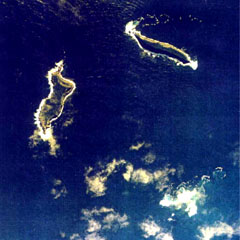Report on Hunga Tonga-Hunga Ha'apai (Tonga) — 18 March-24 March 2009
Smithsonian Institution / US Geological Survey
Weekly Volcanic Activity Report, 18 March-24 March 2009
Managing Editor: Sally Sennert.
Please cite this report as:
Global Volcanism Program, 2009. Report on Hunga Tonga-Hunga Ha'apai (Tonga) (Sennert, S, ed.). Weekly Volcanic Activity Report, 18 March-24 March 2009. Smithsonian Institution and US Geological Survey.
Hunga Tonga-Hunga Ha'apai
Tonga
20.5532°S, 175.3841°W; summit elev. 114 m
All times are local (unless otherwise noted)
Based on information from Tonga Meteorological Services, analysis of satellite imagery, and pilot observations, the Wellington VAAC reported that during 18-19 March ash plumes from Hunga Tonga-Hunga Ha'apai rose to altitudes of 4-5.2 km (13,000-17,000 ft) a.s.l. and drifted NE and about 480 km ENE. On 20 March, steam plumes rose to an altitude of 1.8 km (6,000 ft) a.s.l. Wide-spread haze was reported in areas downwind, below an altitude of 1.5 km (5,000 ft) a.s.l., including in Vava'u, a group of islands about 255 km NE of Hunga Tonga-Hunga Ha'apai. On 21 March, an eruption plume rose to an altitude of 0.8 km (2,500 ft) a.s.l.
According to news articles, the eruption started on 16 March from two vents, one on Hunga Ha'apai and another about 100 m offshore. Video footage and photographs taken from a nearby boat and posted on 20 March showed repeated dark, ash-rich Surtseyan explosions and associated base surges from two vents. A journalist that visited the area reported that the island was covered with black ash, and coconut trees were reduced to black stumps. Dead birds and fish were seen in the water.
Geological Summary. The small andesitic islands of Hunga Tonga and Hunga Ha'apai are part of the western and northern remnants of the rim (~6 km diameter) of a largely submarine caldera located about 30 km SSE of Falcon Island. The topmost sequence of welded and unwelded ignimbrite units from a caldera-forming eruption was 14C dated to 1040-1180 CE (Cronin et al., 2017; Brenna et al. 2022). At least two additional welded pumice-rich ignimbrite units and nonwelded pyroclastic flow deposits, below paleosols and other volcaniclastic deposits, indicated more very large previous eruptions (Cronin et al., 2017; Brenna et al. 2022). Several submarine eruptions have occurred at this caldera system since the first recorded eruption in 1912, including 1937 and S of the islands in 1988. A short eruption in 2009 added land to to Hunga Ha'apai. At that time the two islands were each about 2 km long, displaying inward-facing sea cliffs with lava and tephra layers dipping gently away from the caldera. An eruption during December 2014-January 2015 was centered between the islands, and combined them into one larger structure. Major explosive eruptions in late 2021 initially reshaped the central part of the combined island before stronger activity in mid-January 2022 removed most of the 2014-15 material; an even larger eruption the next day sent an eruption plume high into the stratosphere, triggered shock waves through the atmosphere and tsunami across the Pacific Ocean, and left only small remnants of the islands above the ocean surface.
Sources: Infobae, Wellington Volcanic Ash Advisory Center (VAAC), Agence France-Presse (AFP)

